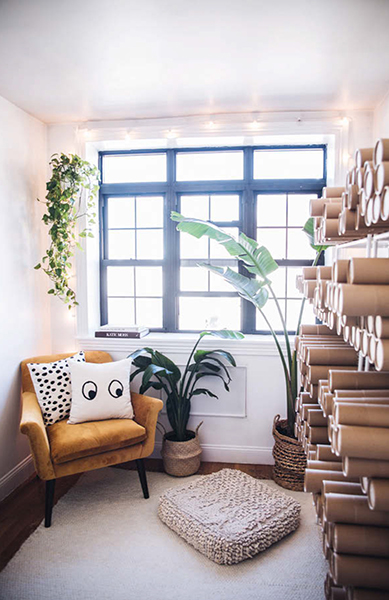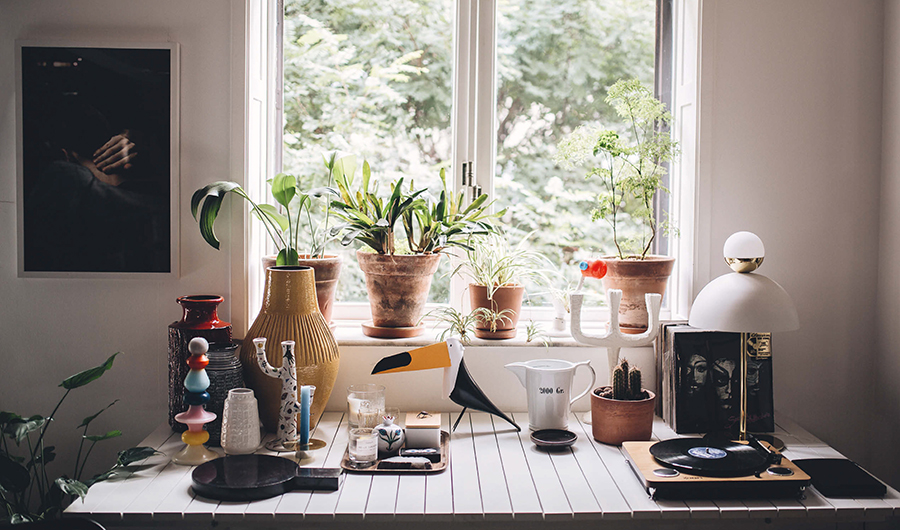
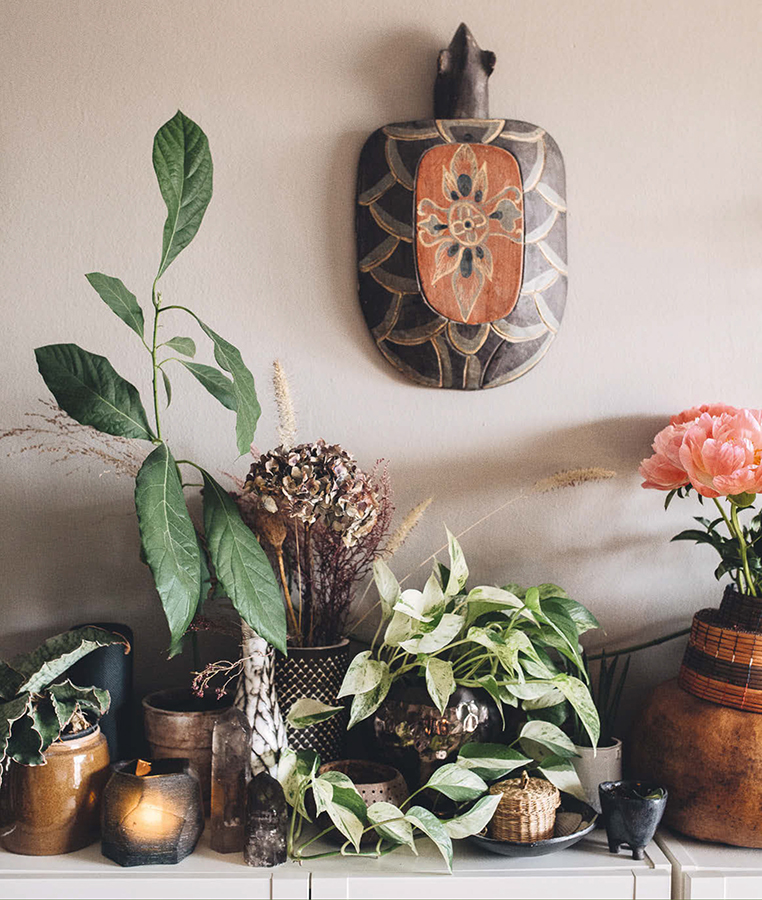
chapter 5
GET CREATIVE WITH PLANTS
Artists and other creative people have flourished among plants for centuries—they drew, they wrote, they composed. Plants have always touched the human soul in the best way possible. Nature—the beauty of lush foliage, the ever-changing colors and shapes, the timelessness, the birth and rebirth—inherently ignites inspiration; nature’s poetic dimensions are many and magnificent. But there is even a scientific way to account for plants’ impact on creativity.
Did you know that the human eye is better at perceiving green than any other color in the universe? Humans are trichromats, which means that we perceive three primary colors: blue, green, and red. The retinas in our eyes can detect light between wavelengths of 400 and 700 nanometers (nm), from blue at 400 nm to green at around 550 nm, to yellow, orange, and red at 700 nm. Green being located in the middle of the visible spectrum, some scientists believe that because our eyes are at the peak of their perception to detect the wavelengths that correspond with the color green, the hue calms us down. Our nervous system can relax when looking at green; the color is one of balance and harmony. On a primitive level we are reassured by green because it indicates the presence of water and thus less danger of famine. Reassurance is also what we feel when we enter a lush botanical garden, walk through a leafy green forest, take a so-called plant bath, or simply visit a local garden center: It is refreshing and calming, and we are aware of the present. Being out in nature also quiets a part of the brain called the subgenual prefrontal cortex, decreasing our tendency to dwell on problems, making us feel more carefree and relaxed. No wonder why we, as a Plant Tribe, are compelled to add these qualities to our own homes and work spaces!
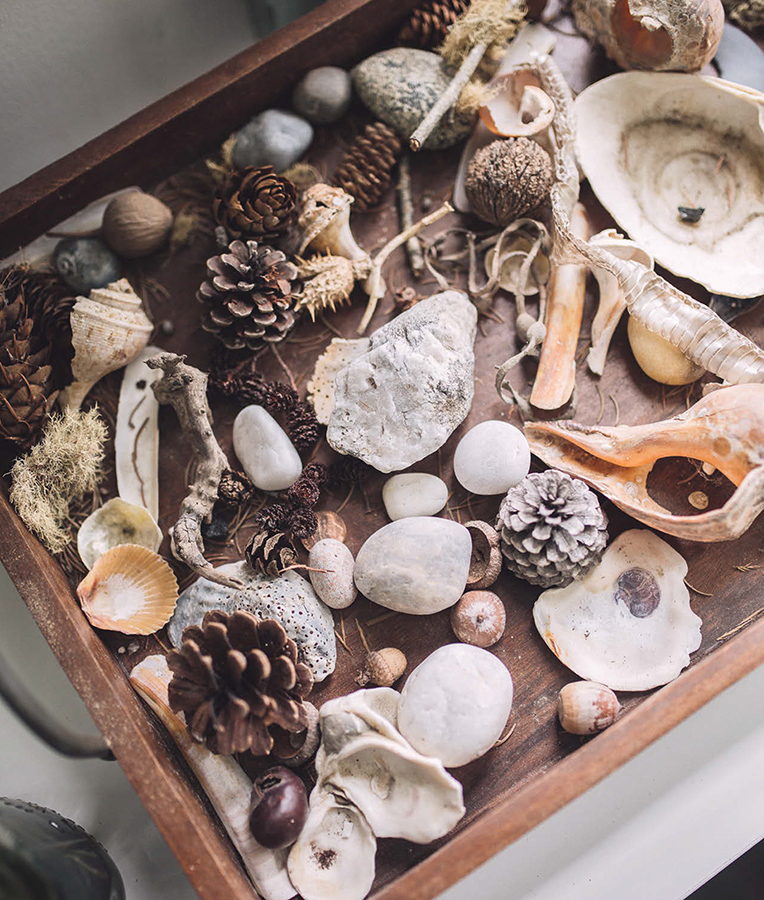
To boost your creativity, spend time in nature, observing and collecting. Nature has inspired humankind since ancient times. Gather little collections of rare stones, crystals, pine cones, shells, and other natural objects to display in your home.
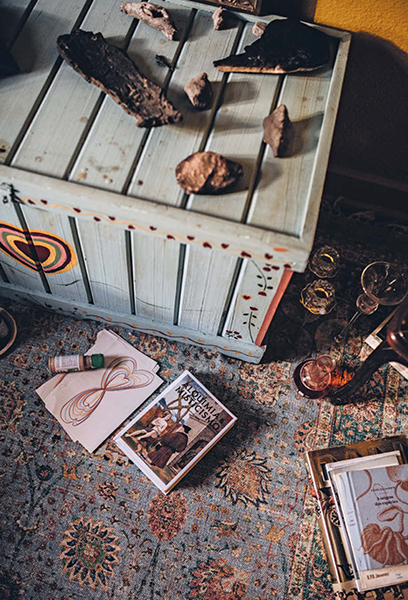
A creative corner in the room of Júlia Anadam (see this page) with collected items. Books, stones, patterns, and colors as well as scents provide a wealth of inspiration to kick-start creative projects.
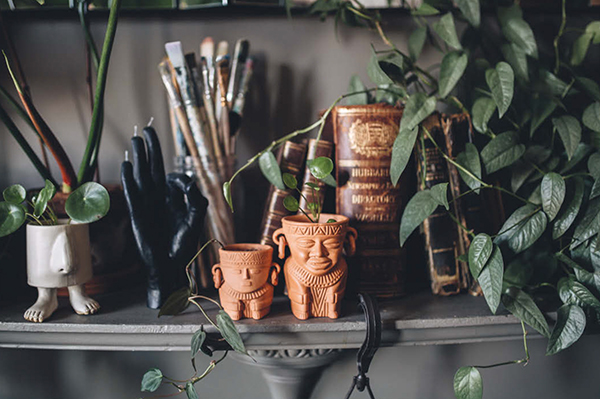
Tribal ceramics brought back from a trip to Colombia sit playfully on Alina’s mantel.
5.1
creativity at work
We believe that adding plants to your work environment is a must: Caring for an office plant, or an entire jungle, creates an opportunity to have a little break from work, dig in the soil, prune, water, and just be present with the plant while forgetting about the stressful meeting you just had or that upcoming deadline. Did you know that a few plants in the office can reduce blood pressure and even prompt more generous behavior toward others? Plants are also great conversation starters: Give them name tags so that your colleagues can ask how you and “George” are doing today. And while you’re on vacation, ask your colleagues to help keep “George” alive. If you don’t want your colleagues to worry about your plants, use a watering globe or terra-cotta watering cone during your absence.
Working surrounded by plants gives you an instant boost of energy and helps you focus on daily tasks—or provides some distraction. The presence of houseplants on your desk refreshes your ability to concentrate because it is passive but also stimulating. It allows your eyes to wander during the day, to appreciate the irregular shapes of a leaf, the interesting patterns, the deep green color . . . When we visited Alina Fassakhova in New York City (see this page), she told us that the presence of plants help her rest her eyes after intense hours of concentration painting a new canvas. It’s essential to her work as an artist to look at greenery and to touch and smell the leaves.
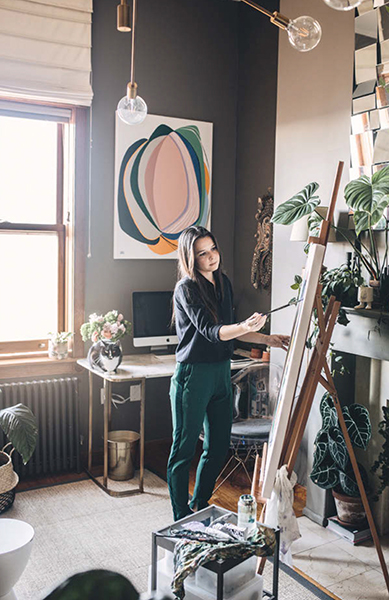
Alina finds inspiration and serenity in her plants while painting in her Manhattan home. The shapes and colors inspire her organic paintings, while the sight of plants also soothes her eyes after long painting sessions.
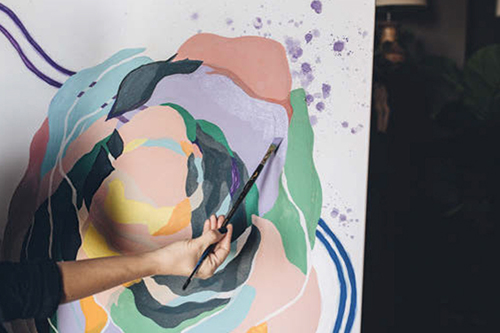
Alina’s painting overflows with colors and organic lines. This one is reminiscent of a flower.
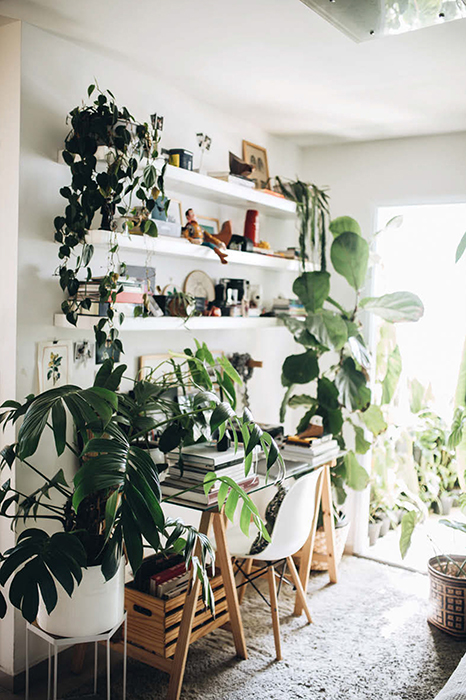
The green home office of Toy Taniel in São Paulo, Brazil.
5.2
when plants drive a business
The organic shapes of plants and the abundance of textures invite us to explore our own creativity, whether in our daily work, in our relationships with others, or by actually making something by hand. Nature, and plants in particular, offers endless inspiration. Plants spark so much joy in some people that they launch an entire business around them. We spoke with three creatives who turned their passion for plants and design into thriving companies.
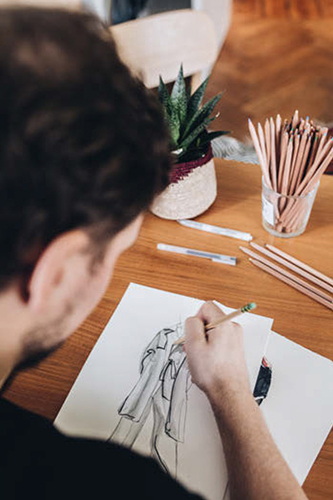
Designer Tim Labenda (see this page) creating in his Berlin home office, which features a big Monstera deliciosa.
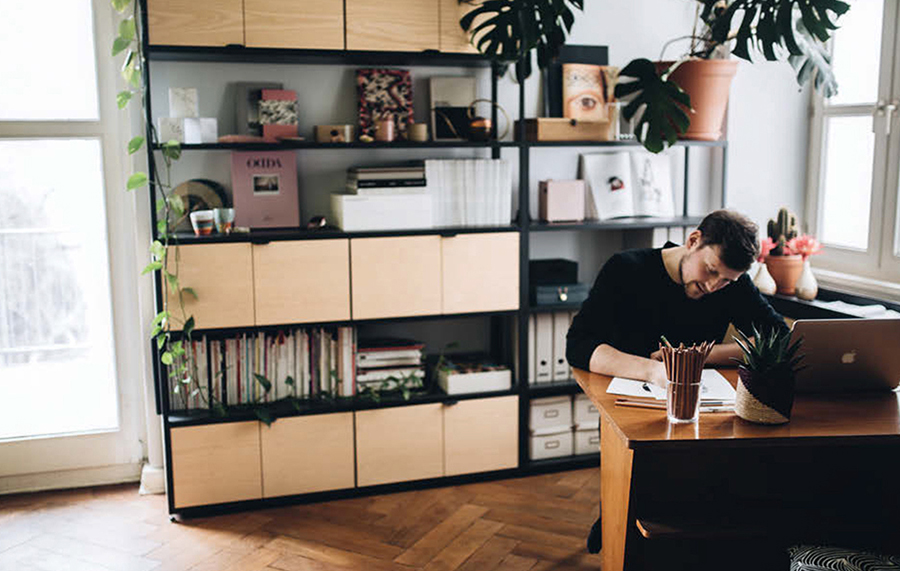
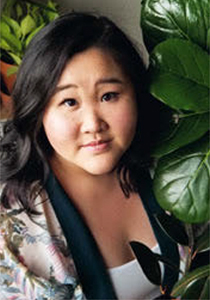
Samantha Leung
Location
Seattle, Washington, USA
Company
HEMLEVA: enameled pins and key chains, air plants, hanging Himmeli ornaments, and more
Favorite plant
Sansevieria
@hemleva
What made you start HEMLEVA?
HEMLEVA began in a pretty nontraditional way. I was in intense physical therapy for a while, and I needed to occupy my time. I started HEMLEVA with one hundred dollars and told myself that whether I make it or I don’t, at least I’ll know that I tried my hardest. To this day I still hand make each and every hanging ornament to order.
When did plants enter your life?
One of my earliest memories is of visiting the botanical gardens with my mom and grandmother. We would slowly walk through each of the different greenhouses and gardens, breathing in the dense humidity and the smell of fresh earth. Plants remind me of a simpler time, spent with people I love.
Has your relationship with plants changed now that you’re working with plants?
I love plants even more now than when I started my business. I have met so many fellow plant aficionados and collectors—and something they all have in common is they are so kind, supportive, and giving.
Tell us about your customers.
There have been so many instances where people tell me that one of my products reminds them of someone they love or someone they lost touch with, and that’s something that I never expected when I started this business—to make something that went beyond being pretty, or functional, and is also meaningful.
What part do plants have in your home life and your work life?
I firmly believe that you should fill your space with things that bring you joy, and for me that means that there are houseplants and lots of Tillandsia. I can’t help but think of them whenever I water or tend to the plants. Instead of scent memories, for me there are plant memories.
What role does sustainability play in your work?
For my Himmeli and wall sconces, I purchase raw materials from the United States, to decrease my carbon footprint;
I offer plastic-free packaging for my key chains, and I am moving toward completely plastic-free shipping materials.
What is your dream project for HEMLEVA?
To design plant propagation accessories: It would mean so much to make it easier to grow, care for, and share plants.
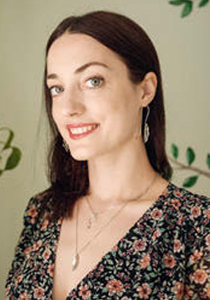
Fanny Zedenius
Location
Stockholm, Sweden
Company
Createaholic: handmade macramé decor and DIY supplies
Favorite plant
Rubber plant
@createaholic
What made you start Createaholic?
I discovered macramé when I was searching for ways to fit more plants in my home. Soon afterward I started mass-producing macramé plant hangers and decided to launch a business! Plants were an important part of my brand from the get-go.
Have you always worked as a creative?
No, I studied international relations and worked for the Swedish National Committee for UN Women for a while. I always thought that my hobby had to remain just that, a hobby.
When did plants enter your life?
I distinctly remember my first plant, which I got when I was about six, was from a cutting of a Peperomia obtusifolia. I watched it grow roots in the water and then planted it and watched it grow, and I became the plant lover I am today! My mother told me that plants like it when we talk to them and tell them nice things, so I talked to that plant a lot.
Do you have a plant ritual?
I sit with my fiddle-leaf fig tree for a couple of minutes every day and shake it a bit to simulate a tropical storm. I heard this could help fiddle figs grow a thicker trunk. It’s a commitment because the trunk won’t adjust straightaway, but I’m in it for the long haul!
What part do plants have in your home life and your work life?
I work from home, so plants are a constant feature in both private and work life. Our apartment has large windows, with plants as privacy screens, but the main reason for having so many is simply that I love them. I honestly can’t imagine not having plants around me; they have such a calming and uplifting effect. Simon [my husband] and I joke that they are our babies.
Do you celebrate business successes in a special way? For example, by adopting a new plant?
Treating myself to a new plant is my favorite way of celebrating.
What role does sustainability play in your work?
Sustainability is something I prioritize. This includes evaluating my use of plastics, asking suppliers to avoid plastic packing, searching for organic materials, and lots more.
What’s your dream project for Createaholic?
Having a collection of more high-end wall hangings and a gallery exhibition.

Octávio Meireles
Location
Brasília, Brazil
Company
Plantestilo: plants and landscaping
Favorite plant
String of hearts
@plantestilo
What made you start Plantestilo?
I majored in international relations and intended to follow a completely different path, but when I was studying for my public service exams, I got very stressed. The one thing that eased my mind was my garden and work with plants. Before I knew it, I was creating my very own fertilizer, then vases, and then my own arrangements. For the first time in my life, I felt absolutely whole. In short, I launched my business to explore the utter joy plants brought to me.
When did plants enter your life?
Growing up, I used to sneak into my maternal grandma’s garage and chew on the stems of her begonia (they are edible and have a distinctive sour flavor). And also, I loved the way my paternal grandma used to tell me stories about the plants and their names.
Has your relationship with plants changed now that you’re working with plants?
I love what I do, and I cannot look at a room without thinking of a thousand different projects for it.
Tell us about your customers.
The question they ask most is, Which plant can you get me that I will be least likely to kill?! People nowadays live such hectic lives and are always trying to combine style with manageability.
Do you have a plant ritual?
The first thing I do when I walk into my store is to take a deep breath and let my gratitude that I am able to do this work for another day sink in. I then check on each plant individually and make a mental list of everything I need to get done that day.
Do you celebrate business successes in a special way? For example, by adopting a new plant?
I celebrate successes with everyone who helped me get to where I am. Plants feed off energy, and I think they take some of my positive energy with them when they go to new homes.
What role does sustainability play in your work?
We work with a plant’s natural life cycle and without artificial greenhouses. Every leaf that drops is put into our compost, as part of our zero-waste policy. Our fertilizer is 100 percent organic matter.
What is your dream project for Plantestilo?
For every plant I sell and for every vertical garden I create to send a little piece of me with them.
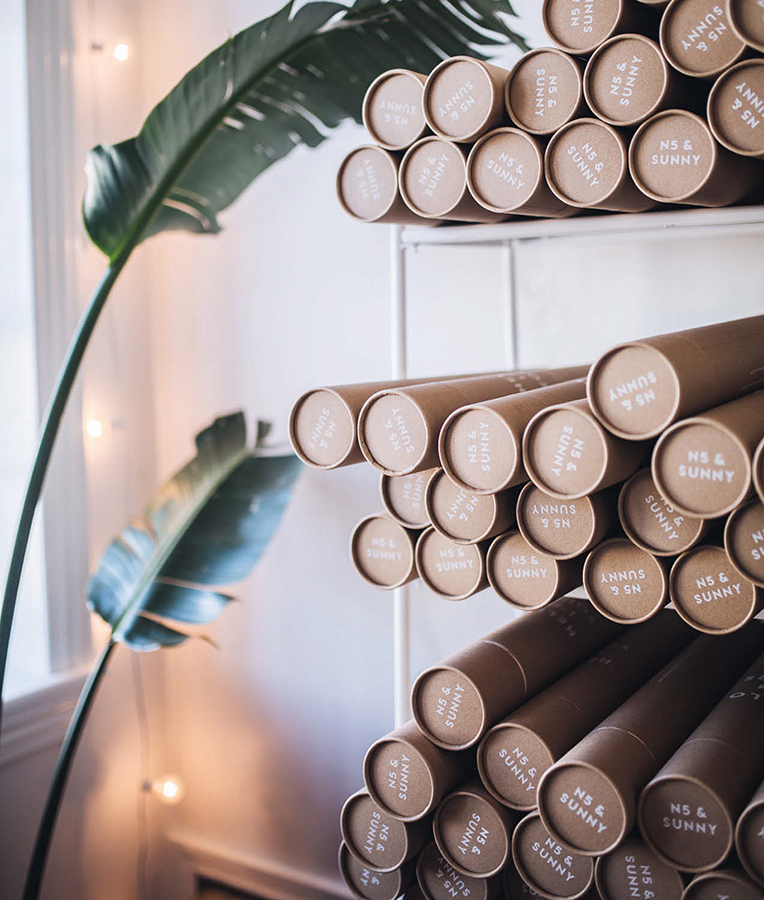
Viktoria Dahlberg’s stock of N5 & SUNNY designs in her green home office.
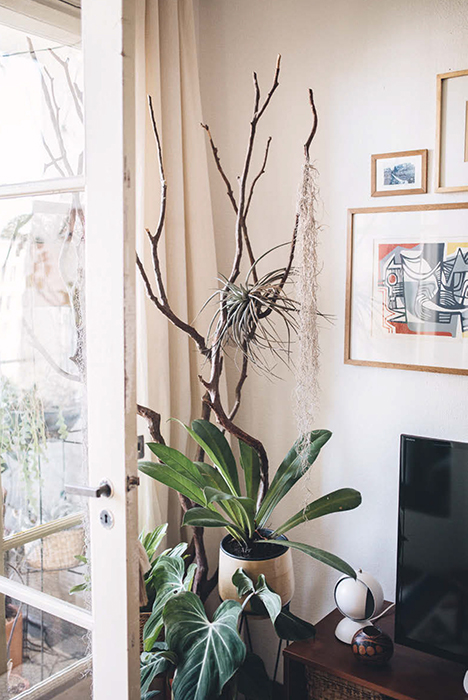
A branch or driftwood can be easily transformed into an unexpected plant holder. Here, Lucas used a branch to hang some of his air plants.
5.3
dress your plants
Think of your collection of plants: Whether you have two plants, twenty plants, or two hundred, they most likely have different shapes, colors, structures, and sizes. But what about their pots? Are they potted in terra-cotta pots, vintage earthenware, synthetic pots, glass containers, fiberglass planters, or contemporary ceramics? Or have you kept them in their plastic nursery or grow pots?
Dressing your plants, by choosing the style of pots for your home, is a personal affair. Some of us prefer plain terra-cotta pots; their natural brown-orange color makes the foliage pop, their weight makes them a steady base for plants, and they are some of the most affordable pots on the market. And because they have been around for decades, you can find the prettiest vintage ones, with mineral deposits on the inside and outside that give them that extra charm. Even if you prefer keeping your palette very terra-cotta but like a more contemporary aesthetic, you can find exceptional pots in terra-cotta that truly stand out, as the material has inspired many designers to get creative. In Olive and Rudy’s home (see this page) in Dallas, you’ll find mostly terra-cotta pots, but some of them have faces: Olive and Rudy added an unexpected twist to the uniform palette of their pots. Our Spanish friends at livingthings created Voltasol, a rolling flowerpot that can turn because of its semi-conical base. Design brands like Ferm Living, Nick Fraser, Skagerak, and Umbra Shift also have very contemporary takes on the terra-cotta pot in their collections.
Terra-cotta literally means “baked earth” and is a clay-like earthenware ceramic that can be either glazed or unglazed. When it’s unglazed, the material is very porous, so the soil dries out faster, letting the roots and potting mix breathe. This means terra-cotta is slightly more suited to plants that thrive in drier soil than to tropical foliage. But if you have a better understanding of the needs of your planty tropical friends, you can let them thrive in terra-cotta pots. Or apply a nontoxic cement sealer, which is made for porous materials, to your pots. You can also use spray paint to seal your pots, but you may want to avoid that with your herbs and edible plants.
If you think that terra-cotta pots are boring: Did you know that terra-cotta (the material) doesn’t just come in “terra-cotta”? Since earth, the main element of terra-cotta pots, doesn’t have the same color and composition everywhere in the world, terra-cotta pots can be different colors. The traditional Iranian pots available from KHASHKHASH are proof: Their colors vary from yellow to blush to beige to deep orange and red.
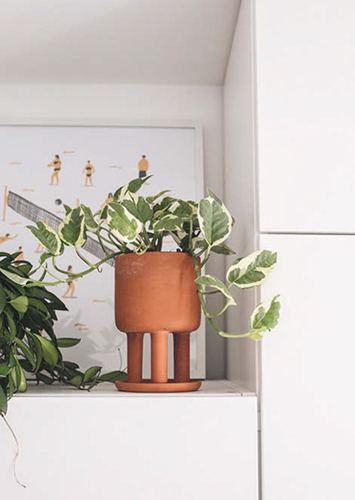
This cute legged terra-cotta “Tri-Pot” by Studio Arhoj adds height to a glacier pothos.
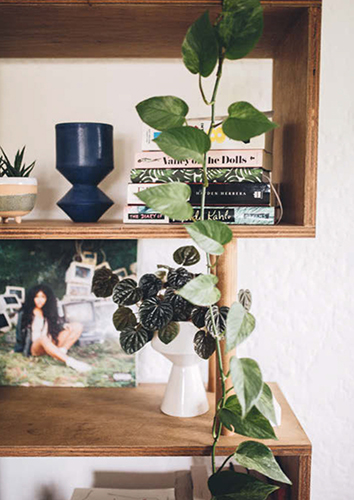
This geometric white planter, which holds a Peperomia, recalls the shape of an ancient vessel.
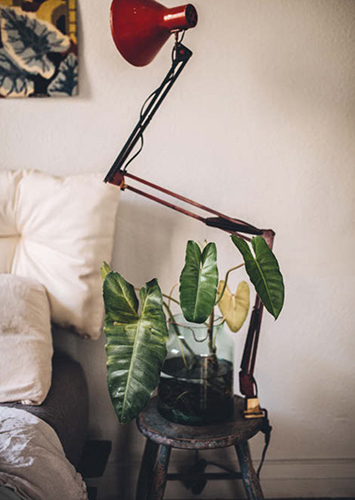
Set plant cuttings in decorative glass vases for a modern, clean look.
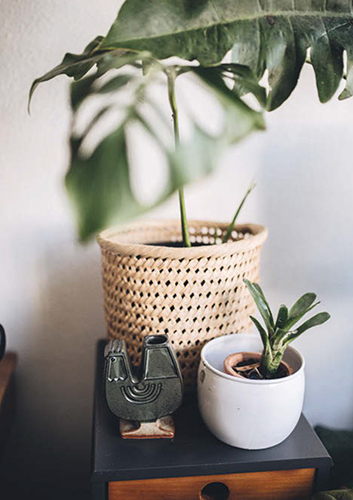
Baskets are perfect plant containers: They add texture and style, and you can hide an unspectacular plant pot inside or keep your plant in the nursery plant pot with a little saucer underneath.
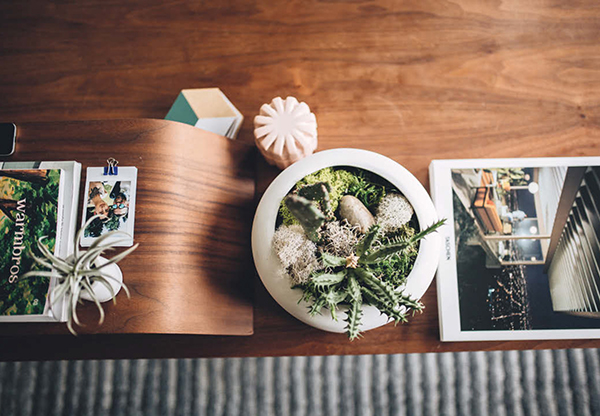
Cacti, moss, and stones are decoratively arranged in a flat, white bowl. Make sure to use a layer of pebbles or sand for drainage in pots without drainage holes.
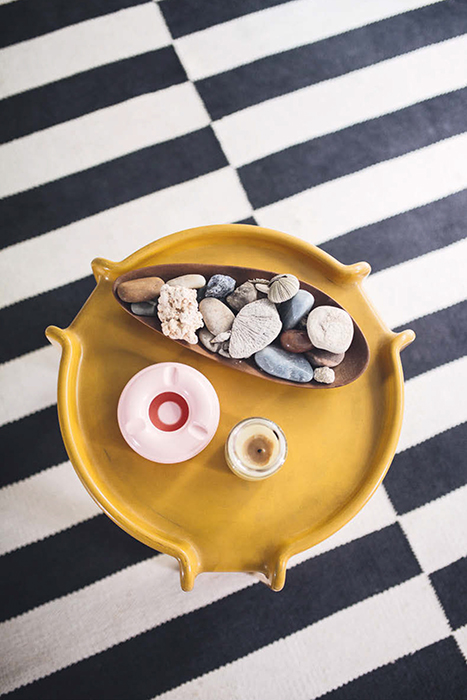
Playing with materials and textures is common when styling interiors. The same is valid when choosing plant pots made of different materials.
5.4
pot materials
SYNTHETIC POTS
Made from non-recycled or recycled plastic, they keep moisture inside the pot and are lightweight, which is ideal when you like to move your plants around a lot.
VINTAGE STONEWARE OR EARTHENWARE POTS
These are fired at a high temperature, which reduces the pots’ porousness and vulnerability to the elements. If a ceramic pot is left out in the cold weather, however, it can crack.
GLASS CONTAINERS
These allow you to see some of the roots through the glass, which is always interesting, but the algae and moisture in the soil, and the lack of drainage holes, can cause the glass to become greenish and the plant to feel poorly because of moist roots. Glass jars, bottles, lab flasks, and test tubes come in handy, however, when you want to propagate cuttings.
CONTEMPORARY CERAMIC POTS
The designs are endless, but the majority of these ceramics come without drainage holes and are to be used as cachepots—to cover the grow pot. There is nothing that a good drill can’t fix, however: Delicately drill one or more holes in the bottom of the pot so that excess water can leave the pot. Or if you are a trained plant parent: Cover the bottom of the pot with clay balls or terra-cotta shards, use water sparingly, and make sure water doesn’t stagnate around the roots and cause root rot.
FIBERGLASS POTS
The lightweight material allows the creation of oversize pots that have the same moisture-retaining characteristics as synthetic pots. Some have the look of concrete.
BASKETS
The secret to a bohemian look with large plants in beautiful handcrafted baskets is to not pot the plants directly in the basket. Simply place the plant in its pot on a saucer inside the basket and remove the plant to water.
RESIN POTS
These are lightweight and come in a wide variety of shapes. Some, like the handmade pots from Capra Designs, even have matching saucers.
METAL PLANTERS
The biggest issue with metal planters is not the (possible) rust (iron oxide is insoluble in water and doesn’t get to the roots) but that metal pots are prone to overheating, and excessive heat in a container can stress, damage, or even cook plants’ roots. Copper is toxic to air plants, and, as with brass and zinc versions, it’s better to use copper planters as decorative cachepots that conceal the grow pots. Powder-coated metal is safer for plants, as long as you keep the planter from becoming a stove for your plants.
TIN CANS
To prevent nicely decorated or plain tin cans from rusting when you use them as planters, coat the inside twice with clear enamel rust-resistant spray paint. Make sure to cover the creases, seams, and rims. Don’t place the cans on a sunny windowsill, because the sun will cook the plants’ roots.
CONCRETE POTS
High-quality concrete pots are 100 percent waterproof, and if they don’t have drainage holes, you can use them as you would contemporary ceramic pots.
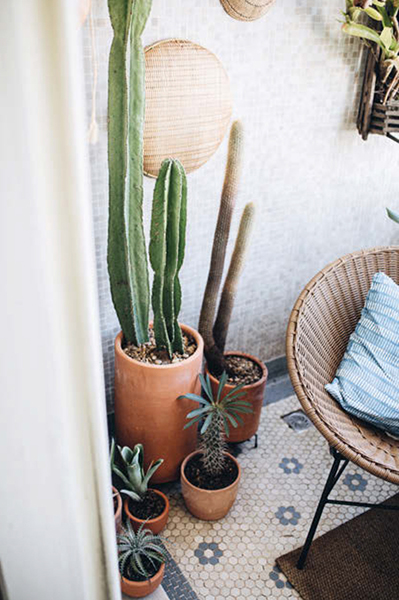
Group planters of the same material together. This is a simple way to make a plant grouping visually coherent and appealing.
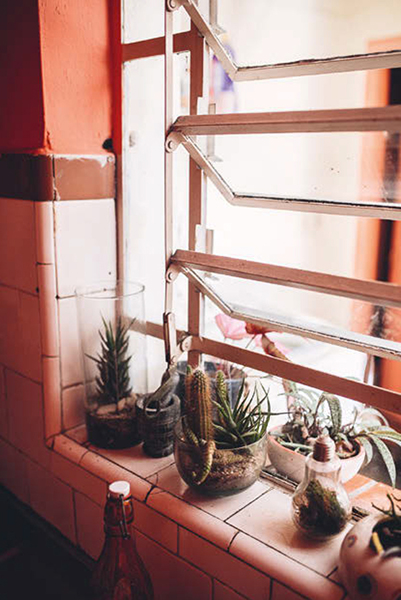
Glass vessels, bowls, mugs, and a light bulb—get creative when choosing the materials for your plant pots.
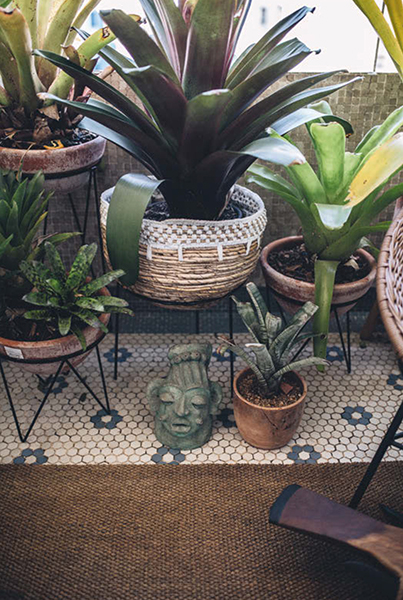
Use plant stands to play with height—you can place terra-cotta pots on metal plant stands and add an unusual basket for a visual surprise.
CACHEPOTS
The easiest way to instantly update a pot is by inserting it into a nicely decorated cachepot. These come in stiff neoprene (at Pijama) or slouchy cotton (at Skinny laMinx), or you can make one yourself (see this page).
FELT POTS
Made from hand-felted wool, these pots give your plants a warm, cozy feeling, as if from a snug winter sweater. Those from Aveva Design are sealed on the inside with natural rubber, so you can water your plants without destroying the felt.
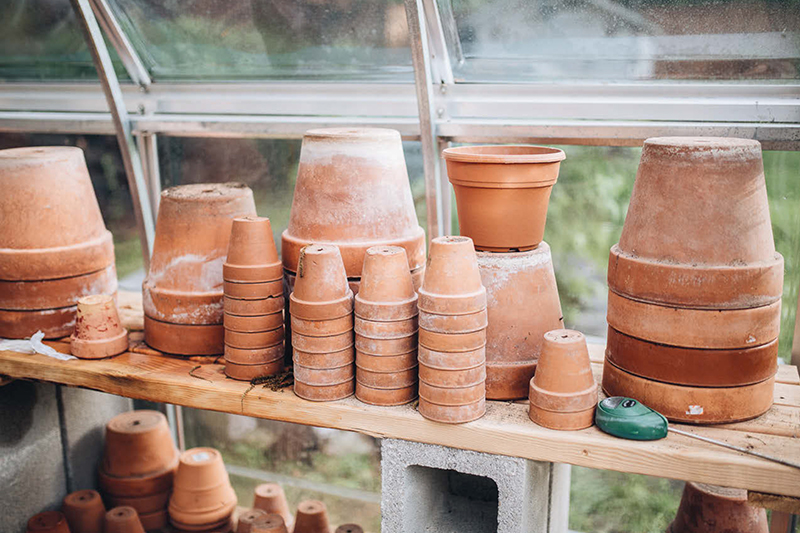
Always a good idea for plant lovers—keep extra terra-cotta pots on hand for new plants that you acquire over time.
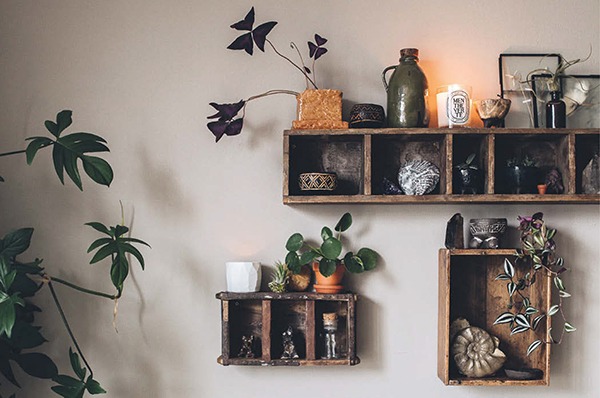
Plant shelves become more interesting when they hold a mix of objects: Here, handmade ceramics, crystals, candles, and found objects mingle with a few plants on vintage shelves.
5.5
creative projects
Being surrounded by plants can fuel a creative project that has nothing to do with greenery. But it is equally fun to be creative with your plants by updating the look of their planters or making them a new home in the form of a hand-knotted plant hanger or plant stand. Here’s a list, by no means exhaustive, of easy creative projects for you . . . and your houseplants:
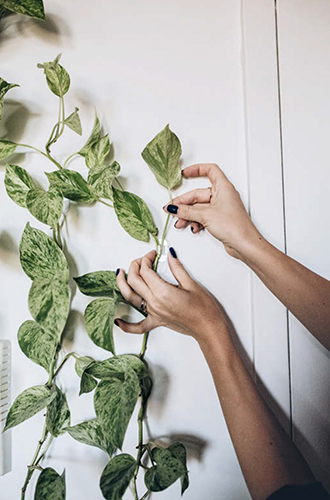
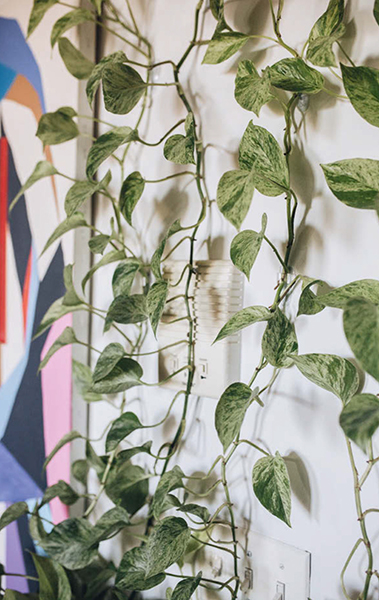
Alina creates a green wall with her pothos by using simple, invisible cable hooks. The effect is stunning; an easy DIY idea for every home!
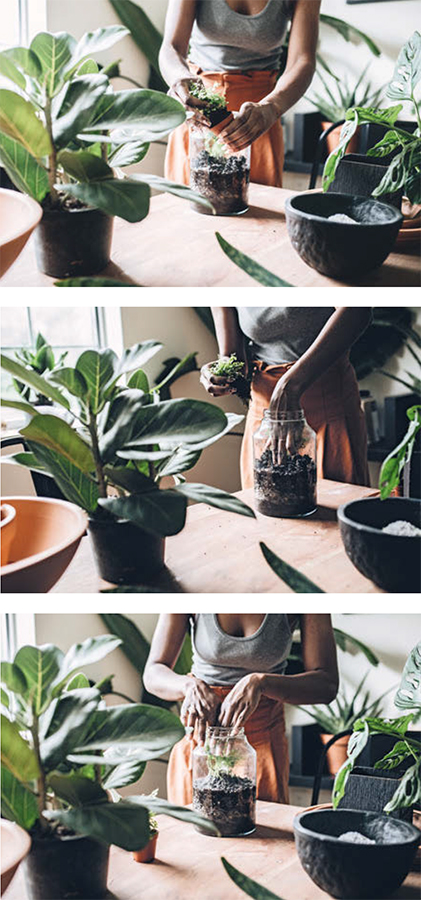
Simple, stylish, and practical: Jennifer makes clever terrarium lamps by filling a large glass jar with terrarium potting mix and plants such as Fittonia, Peperomia, or little ferns. She finishes the project by adding a lamp socket and lampshade.
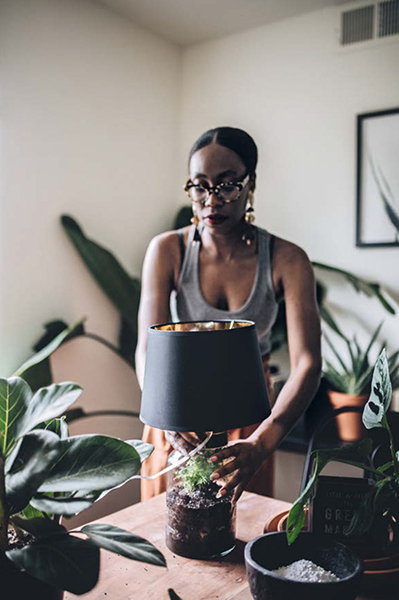
- PAINT OLD CERAMIC POTS with chalk paint to give them a new look. You don’t even need to prime or seal the paint, as chalk paint can be applied to any porous surface.
- MAKE YOUR OWN CACHEPOT from leftover fabric or old cushion covers and curtains. You don’t need a sewing machine or professional sewing skills for this: Fold a rectangular piece of fabric in two, with the right side on the inside. With some simple stitches sew the longer sides and one shorter side together. Turn the tube right side out. Place a tray in the base of the tube to keep the cachepot from becoming wet and stained. Insert the pot into the cachepot and fold over the unfinished top until it just covers the pot inside.
- GO THRIFT SHOPPING: You’ll find the best treasures at garage sales, thrift shops, and secondhand markets. Remember: If the color of the pot is not your style, paint it to match your color scheme. Focus on the shape and size of the pot. Check out vases, too, as some tall vases have enough space for plants and their roots. Small glassware items can be used as a propagation station (see this page), and basically any container, like a fruit bowl, a trash can, a boot, a kids’ toy, or a baby bathtub, can be turned into a pot.
- THRIFTED CAKE STANDS, pie trays, oven dishes, and pudding bowls are stylish alternatives to cheap plastic plant trays. Or spray-paint faceted glass bowls and use them as saucers.
- STACK POTS OF DIFFERENT SIZES and shapes and glue them together to create a plant totem pole.
- JOIN A POTTERY CLASS and create your own pots and saucers.
- KNOT YOUR OWN PLANT HANGER from ribbons, fabric, yarn, or cotton cord.
- CREATE A PLANT STAND from wooden broomsticks and copper connectors, or use the frame of an old lampshade as a stand to hold a pot.
- DRY THE WILTED LEAVES of your plants in a flower press, or inside a heavy book weighted on top. When the leaves are fully dried you can frame them as souvenirs of the once happy leaves of your plant.
- ATTEND A TERRARIUM WORKSHOP and create your own miniature jungle.
- CREATE YOUR OWN PROPAGATION CONE from some water-resistant fabric. Cut out a circle with a 5-inch (13 cm) diameter and cut a hole in the middle with a diameter of 1 inch (2.5 cm). Remove one-eighth of the full circle and stitch the two ends together to create a cone. Use the propagation cone on top of a glass jar to grow an avocado seed (see this page) or to keep a cutting from falling into the water.
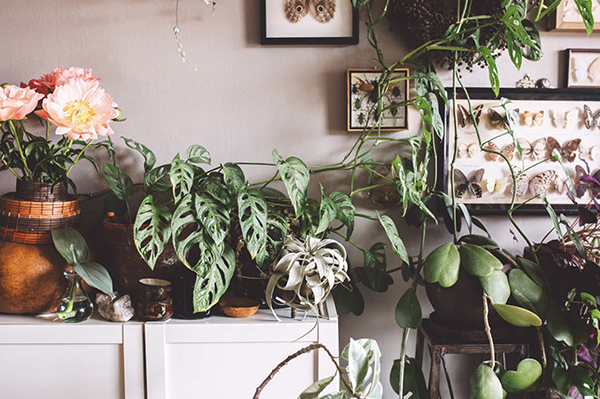
Plant styling gets even more interesting when you add other decorative elements into the mix. An unusual vase, fresh flowers, a personal collection—the results look appealing and effortless.
5.6
simple plant styling tricks
When your plants are thriving and they are potted in pots that suit your interior decorating style, what else can you do to make them look their best and have the most visual impact in your home? Try any of these simple (but magic) tricks:
CREATE A “PLANT GANG”
The number-one advice for anyone who owns more than four houseplants is to gather them in a group. Think of them as you would when you take a family photo: The taller ones go in the back, the children in the front. Pair a spiky cactus with a leafy banana plant, a patterned Calathea, a bushy Dracaena, and a deep red Oxalis triangularis for an interesting mix. And remember the famous styling trick: Uneven numbers work best when displaying several items together.
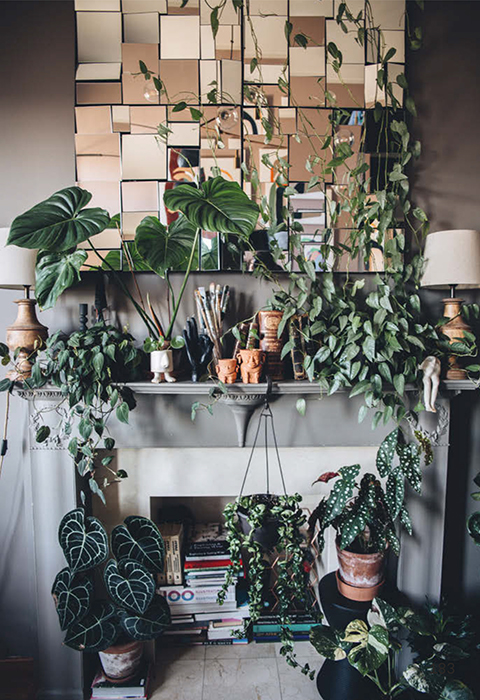
For impact, group your plant gang in a single area and add unusual accents like the traditional ceramics from Colombia and fabulous mirror here.
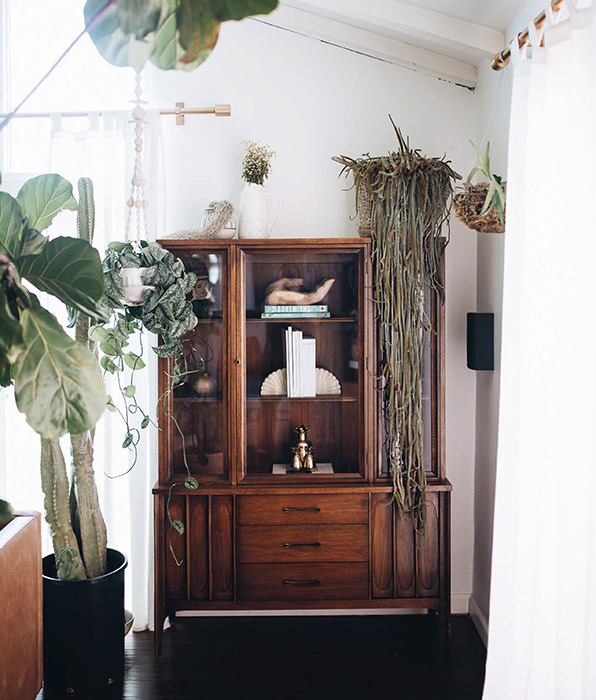
Play with height by using hanging planters as well as tall plant pots.
PLAY WITH HEIGHT
A potted plant may look all right on the floor, but if you place it on a stool or a pile of books or magazines, it acquires more height and instantly becomes more impressive and jungly. Create a room divider by placing your plants in a plant stand or legged plant boxes. Especially tall, vertically growing plants, like Sansevieria, have nice room-dividing characteristics.
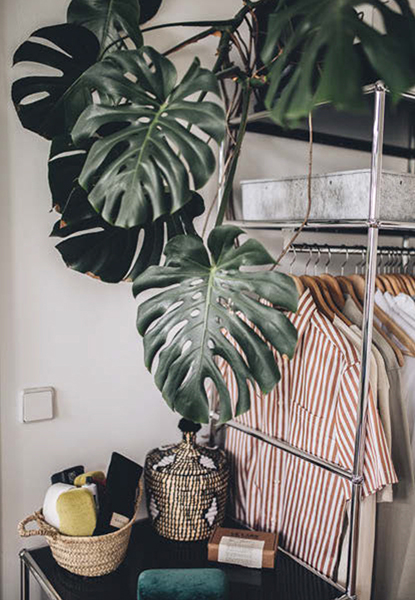
How about a Monstera deliciosa on your wardrobe? It looks absolutely great in this Berlin home. Additional benefit: It keeps the plant safe from your pets.
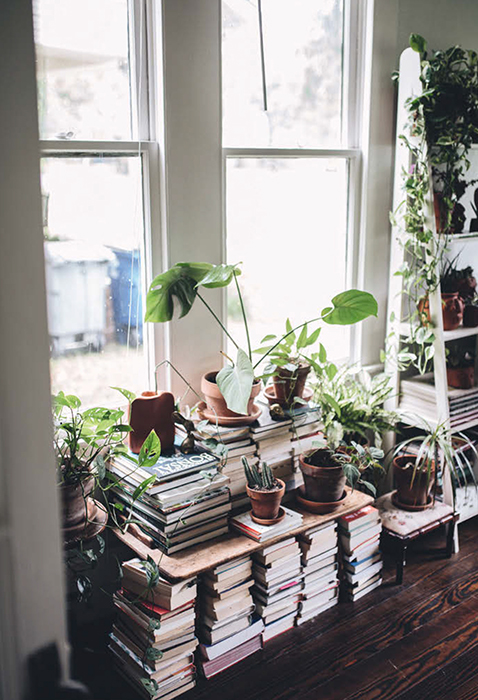
Bibliophiles, listen up! Pile up some of your old books to create extra space for plant displays. Here, a wooden plank adds even more height for this plant collection.
HANGING PLANTS
Instead of placing your plant on a table or the windowsill, hang it from the ceiling. This creates a nice dynamic in a room without taking up precious floor space. The visual effect is extra spectacular if you hang three or more medium or large plants. If your ceiling can’t tolerate the weight, you can hang your plants from a curtain rod in front of a window, or run a metal wire between two walls.
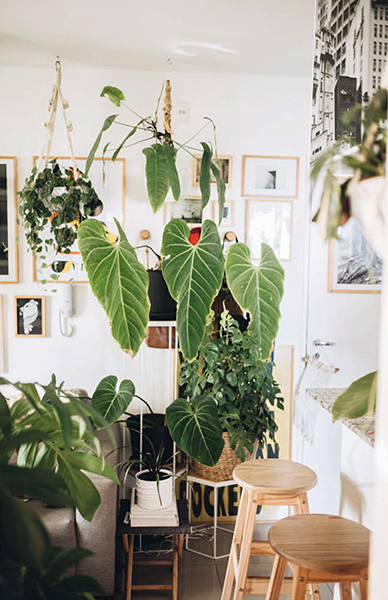
In a small apartment, stools, side tables, plant stands, and plant hangers are the perfect solutions for freeing up floor space.

If you are on the handy side, create a floating plant board above your dining table. A simple wooden board, ropes, and trailing plants are all that is needed. For a more sophisticated version, add light fixtures as seen here.
GROUP PLANTS BY TYPE
If you love cactus plants, create a little cactus area with all your potted cacti instead of scattering them around your home at random. Maybe you’re a fan of tropical aroid plants and have quite a collection. Place them on a round coffee table in their favorite spot and add your misting device. Pairing plants with similar care needs makes taking care of them so much easier, too.
ADD COLOR
Not a fan of green? Have a look next time you are in a plant shop: There are quite a few plants that come in a variety of colors such as burgundy, pink, red, white, or orange. Create a colorful scene at home with all your non-green plants. Plants with outstanding colors include Croton, Oxalis triangularis, Begonia rex, Caladium, Fittonia, Philodendron ‘Pink Princess,’ Tradescantia zebrina or T. pallida, Hypoestes phyllostachya, Echeveria ‘Purple Pearl,’ Coleus, Gynura aurantiaca, and Aglaonema ‘Pink Anyamanee.’
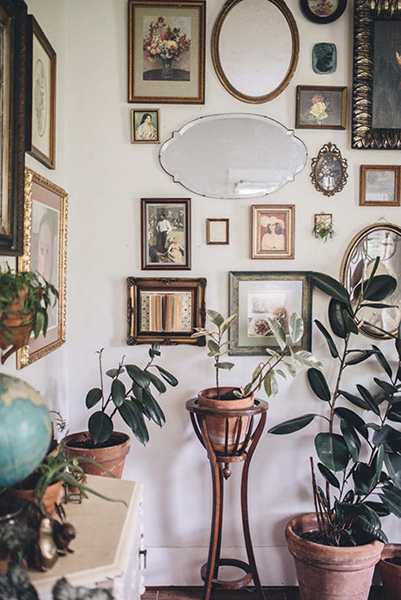
Three Ficus elastica, one of them variegated, group together nicely in this Dallas home.
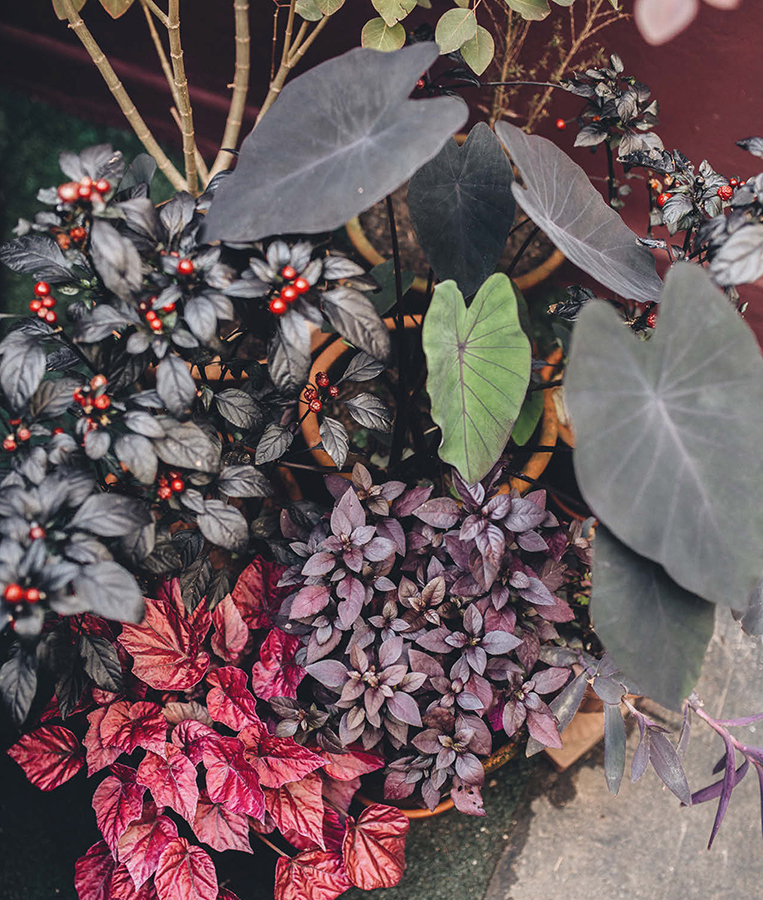
Plants don’t only come in green! This courtyard garden shows off deep shades of purple, pink, and almost black for a stunning color effect.
MAKE A PLANT SHELFIE
What’s more fun than a nice shelf filled with personal trinkets and a variety of plants? Unicorns and rainbows? No, seriously, we love a good plant shelfie! Plants can grow up or down, or you can use a plant as a paperweight on a pile of good books, add a nice candle, a travel souvenir, a small clock . . . the options are endless. Plant shelfies are both decorative and practical, as you get to show off utilitarian objects as well as some artistic items.
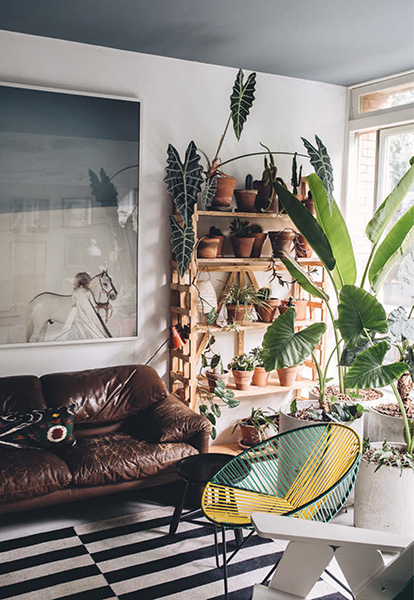
A simple wooden shelf unit looks amazing with a collection of plants in terra-cotta pots. Using the same pot material creates visual unity and makes a stylish statement.

Plants combine with art, baskets, tribal ceramics, glass domes, and a green backdrop to create the perfect plant shelfie in a home office.
BUILD A BOTANICAL THRONE
When your plants are taken care of, it’s time to enjoy their presence and relax: Find a corner in your home and surround your favorite lounge chair with some oversize plants, and keep adding plants until it feels jungly. Then add a coffee table, your favorite drink, and a good book, and sit back and chill. You deserve it!
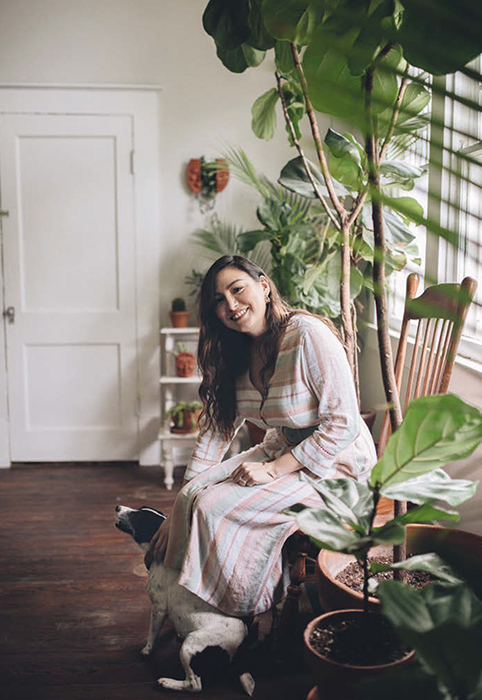
Olive sits on her Insta-famous botanical throne in the company of dog Mylee.
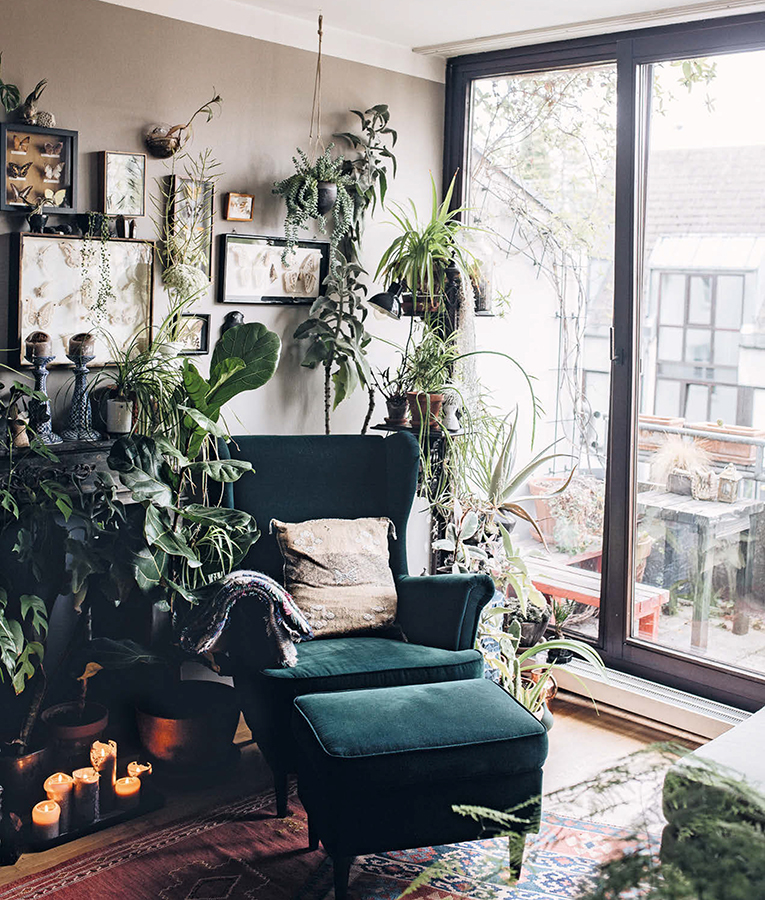
A reading nook gets the royal treatment with a cozy green velvet armchair framed by a lush fiddle fig, spider plants, aloe vera, and a tall Kalanchoe beharensis.
plant tribe stories . . .
Alina Fassakhova
“I love my plants and they love me back.”
Location
New York, New York, USA
Profession
Artist
Zodiac
Aquarius
Lives with
Husband Artem and cats Usha and Sofie
Apartment size
400 square feet / 37 square meters
Favorite plant
Monstera deliciosa variegata
Plant decor idea
Hooks for climbing plants are perfect for small spaces and add life to your walls. Invisible cable hooks work perfectly!
Number of plants
More than 50
@alina.fassakhova
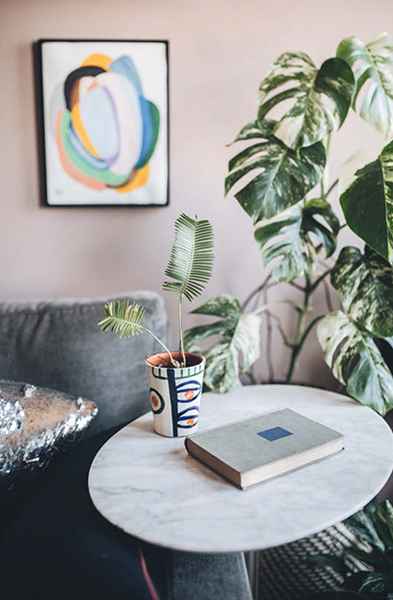
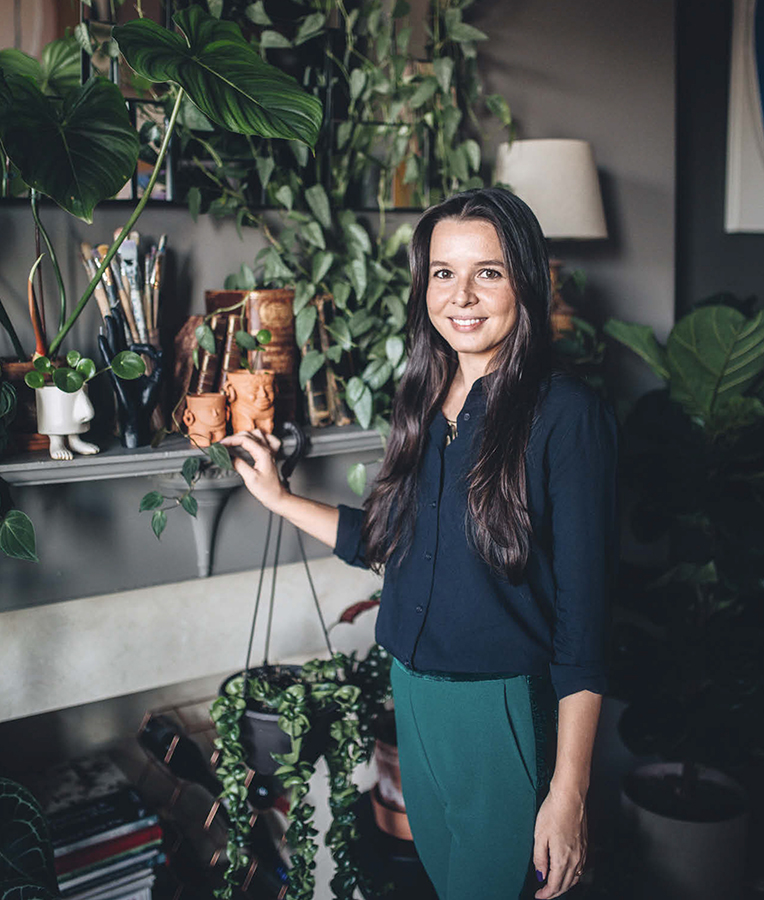
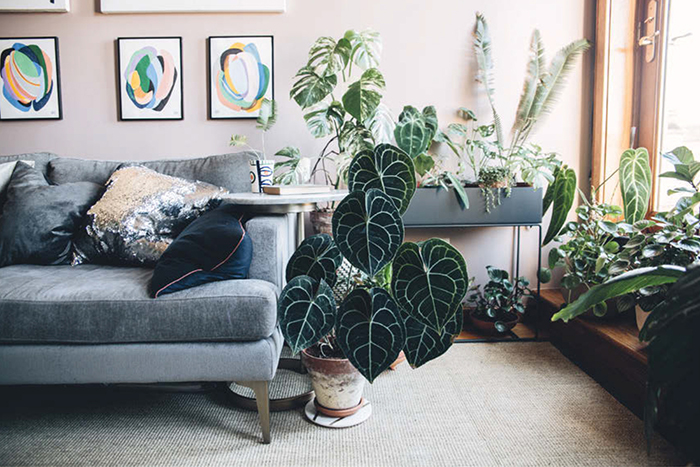
Makes your heart skip a beat: the big heart-shaped leaves of an Anthurium clarinervium in Alina’s home.
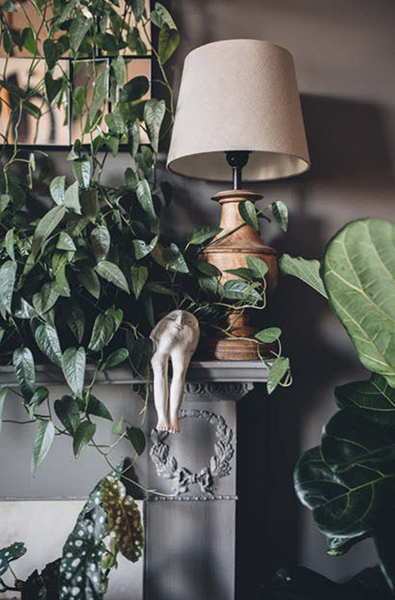
A calm moment in the bedroom with plants and cat Usha.
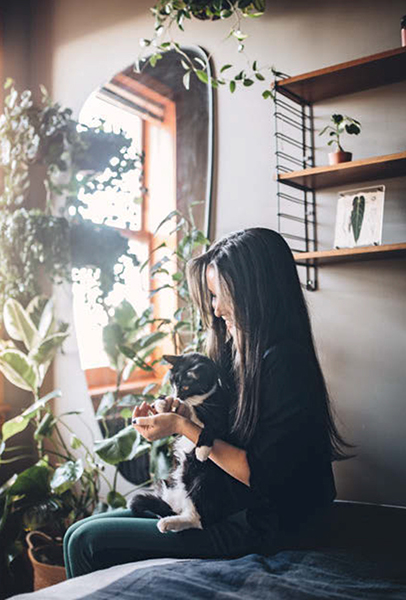
A quirky figure plant pot handmade by Spanish ceramicist Flora Veiga enjoys its spot on Alina’s mantel.
The dawn of a new day is serene and filled with positive energy in this small and charming apartment on the Upper West Side of Manhattan. High ceilings and beautiful details like carved wooden door frames vie for the eye’s attention. But here the competition is tough—more than fifty lush plants create a real urban jungle vibe in this New York City home.
Alina Fassakhova, an artist with Russian roots, lives in this apartment with her husband, Artem, and two jolly cats named Usha and Sofie. Alina’s day starts with a morning ritual, and her beloved plants play a crucial role in it.
Whether the day begins with a moody vibe or a cheerful one, Alina’s morning ritual ensures she has plenty of positive energy from the earliest hours. Welcoming the day begins with thirty minutes among the plants. Alina checks each plant, watering and pruning the ones that need attention, and gently touching them. It is a mutual experience: She takes care of her plants and her plants take care of her. There is a flow of energy between them that is almost palpable at times. Alina says, “Plants are crucial for me. I start the day with my plants to find inner balance. They help me concentrate and focus. This is a positive energy that comes back to me and fuels my body.”
Alina has a deep connection with her plants. As an artist, she draws profound inspiration from them. “I paint surrounded by plants; I cannot imagine any other way. All the shapes, the colors, the lines—everything comes from the natural inspiration that I get from plants. Even though my paintings are now more colorful, the inspiration comes from my plants. Also, after a full day of painting, my eyes need some rest; here, again, the plants come into play. They help me relax and rest my eyes after a long painting session.”
Like many plant-filled spaces, Alina’s home brims with positive energy and creativity. Her paintings hang above the sofa and lean on the walls; the easel sits in a corner of the living room. Usha and Sofie play; sometimes they roam around or nestle among the plants. A faux fireplace is the absolute eye-catcher, packed with plants from floor to mantel. A faceted mirror multiplies the green effect and draws attention toward the high ceiling.
For Alina, groupings of plants all around the apartment ensure she spends enough time with her greenery. She feels—as many plant owners do—that plants need time and attention in order to thrive. “The more time I spend with my plants,” she says, “the better they look. They respond!”
To keep things growing during the somewhat tricky New York winters, Alina uses humidifiers and grow lights. Since grow lights can look a bit too industrial in a beautifully styled home, Alina installs the bulbs in regular light fixtures. It looks great and is a simple and effective solution.
plant tribe interview . . .
Maurício Arruda
“The process of growing a plant is what I enjoy most.”
Location
São Paulo, Brazil
Profession
Interior designer, architect, television host
Zodiac
Taurus
@mauricioarruda
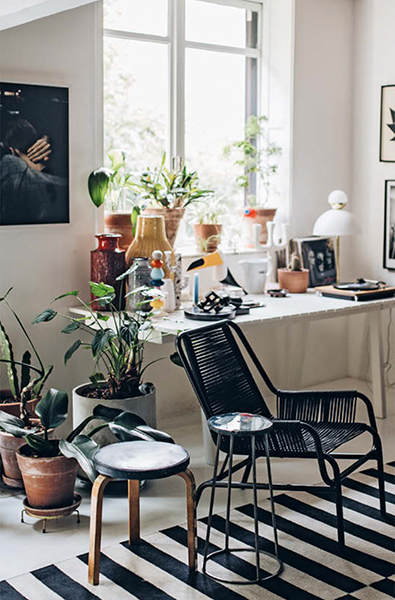
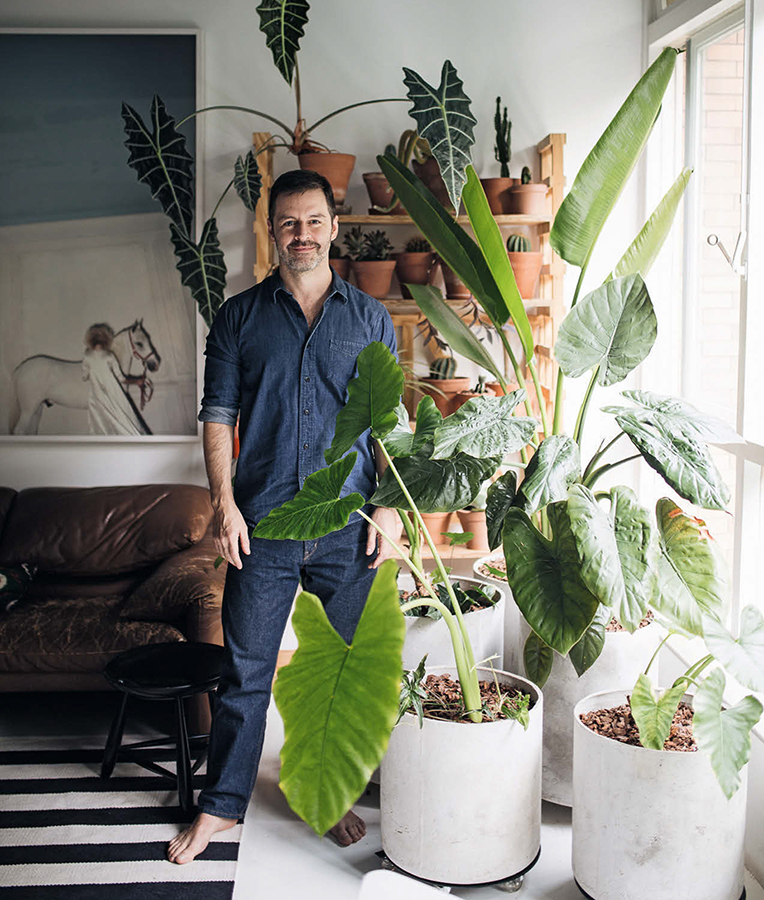
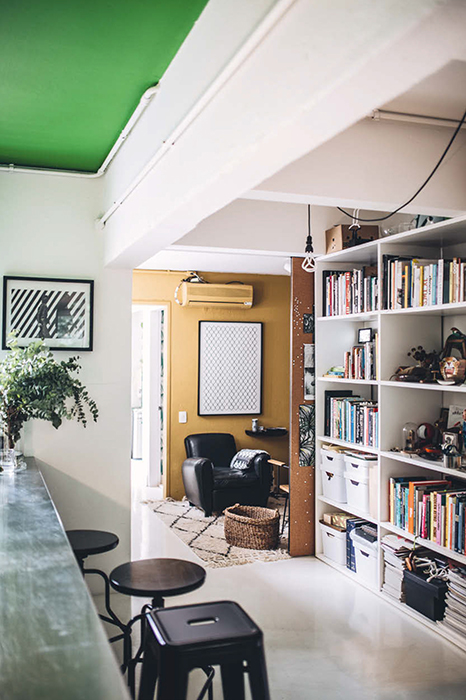
Painting the ceiling a bright green echoes the greenery in the home.
We sat down with Brazilian interior designer Maurício Arruda and asked him three questions about plants in interiors.
What is your personal connection to plants?
For me, plants represent the flow of life and the true sense of being alive to nature and the seasons. Plants keep me balanced in the pace of a huge city like São Paulo. Like caring for pets, cooking, or going to the gym, taking care of my plants reconnects me with the present.
Like many in the Plant Tribe, I see plants less as objects and more as living beings. The process of growing a plant is what I enjoy even more than their aesthetics. I observe them; they talk to me and tell me when something is wrong, or when they need more light or a sip of water. In my plant-filled home I even maintain a little “plant hospital” near the laundry room—a spot I pass multiple times a day, which helps me remember to check on the plants and try to help them feel better.
How do you work with plants in your clients’ spaces?
At work, greenery is essential to any new space design. But instead of creating an urban jungle, I work with plants my clients already own—or I propose a small selection of plants that they can grow over time. By starting small, my clients make plants part of their routine and they learn to take life slowly and appreciate a different pace.
Can you tell us more about the Brazilian DNA in design?
This approach to design meshes perfectly with everyday Brazilian life. In general I’d say that Brazilians like to create something extraordinary by using ordinary things. At home we value a warm atmosphere and spend a lot of time with our families and friends. The kitchen is the heart of the home and there are always extra seats or floor cushions for last-minute visitors. In my own home I encourage movement and flow by not owning a coffee table. Because there’s no coffee table to gather around, everyone circulates through the living room and sits where they like: on one of the sofas, on a pouf, or near the plant shelves.
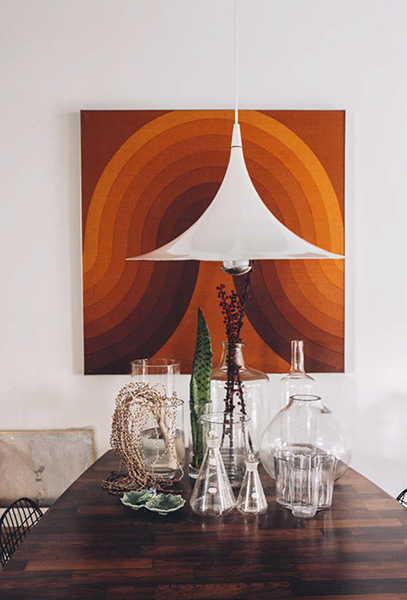
A botanical still life with lab flasks, ceramic leaf plates, glass vases, palm tree seedpods, a Sansevieria cutting, and some branches.
plant tribe stories . . .
Tim Labenda
“Our plants grew to our hearts! They are balm for the soul.”
Location
Berlin, Germany
Profession
Creative consultant, designer
Zodiac
Scorpio
Lives with
Boyfriend Hannes and dog Putin
Apartment size
1,290 square feet / 120 square meters
Favorite plant
Fan palm
Plant decor idea
Go for large and mature plants. I prefer one big plant over ten small ones. A big plant really makes a statement!
Number of plants
56
@timlabenda @hnns.vncnt
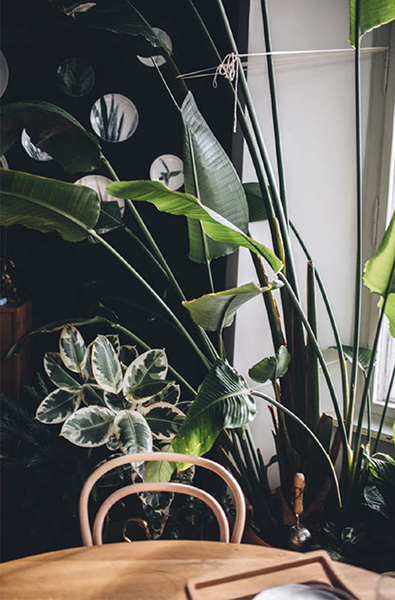
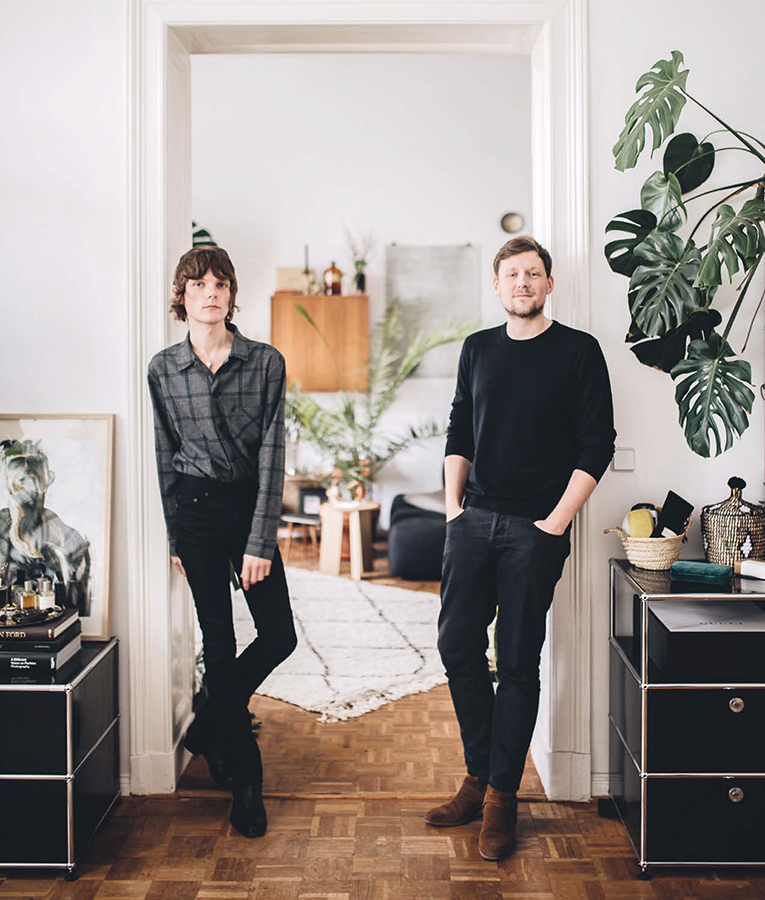
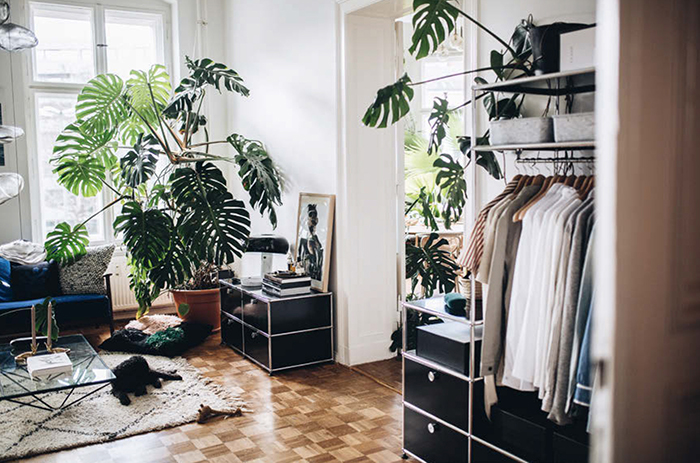
The mother plant of all monsteras in their apartment sits in a sunny living room corner.
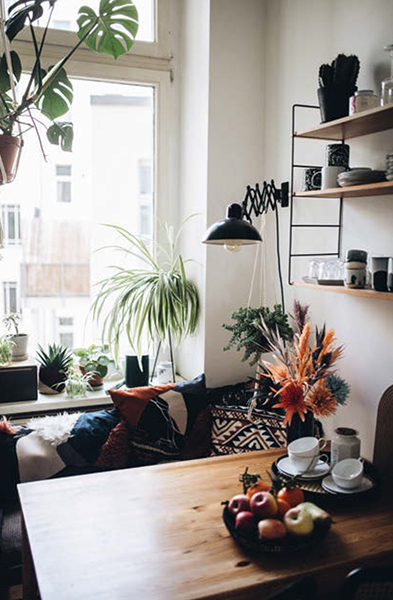
Plants, dried flowers, and cushions designed by Tim in their breakfast nook.
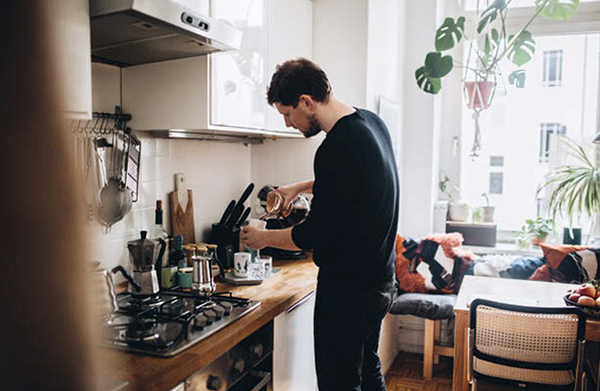
Plants are a constant inspiration for the couple’s creative projects. And coffee is the fuel.
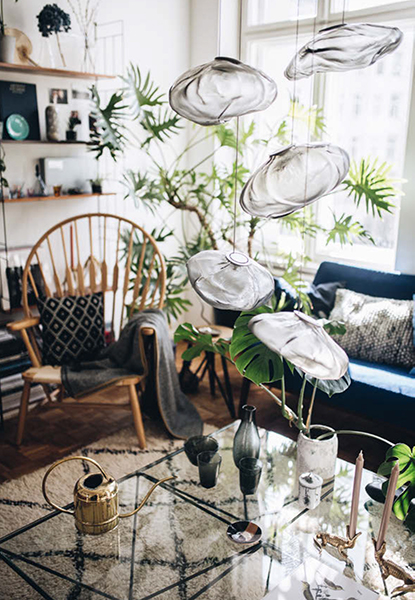
Peek in the living room with the fabulous Bocci pendant lamp.
The moment you enter the home of Tim and Hannes, in Berlin’s Kreuzberg district, you know they are creative souls. Refined furnishings are accentuated with handmade design pieces, and everything is framed with lush tropical plants. The light-filled home is a real jungle—with a fifteen-year-old Monstera deliciosa enthroned in the living room and a tall bird-of-paradise swaying in the dining room. Everywhere, fan palms, big philodendrons, and climbing pothos catch the visitor’s eye, yet it all seems in perfect balance, clearly the work of an experienced designer.
Tim and Hannes have been living in this spacious apartment for nearly five years now. Their passion for plants was ignited first by the design of a favorite shop—they loved the look and wanted to re-create something similar at home. More inspiration came from the famous Chateau Marmont in Los Angeles. For the creative couple, it became clear—they needed to have an urban jungle at home.
Tim explains their plant shopping strategy this way: “We were very strategic in our choice of plants: We made a wish list knowing exactly what we wanted, then we searched for large, mature examples.”
Plants also play a key role in their creative work. “We are both very connected to nature and love being outside,” Tim says. “Being in nature replenishes our inspiration. The organic shapes and the different haptic experiences influence our creative process, whether we are designing fashion or home decor. And having plants creates an ongoing light, relaxed, holiday atmosphere at home.”
Hannes shares the love for plants with equal vigor and passion. “A home should be an oasis . . . and plants create this feeling—they are a balm for the soul.”
plant tribe stories . . .
Viktoria Dahlberg
“Where there are plants there is love.”
Location
Brooklyn, New York, USA
Profession
Designer, photo editor
Zodiac
Virgo
Lives with
Solo
Apartment size
800 square feet / 74 square meters
Favorite plant
Palm trees
Plant decor idea
#plantgang forever <3
Number of plants
11
@viktoria.dahlberg @northfifthandsunny
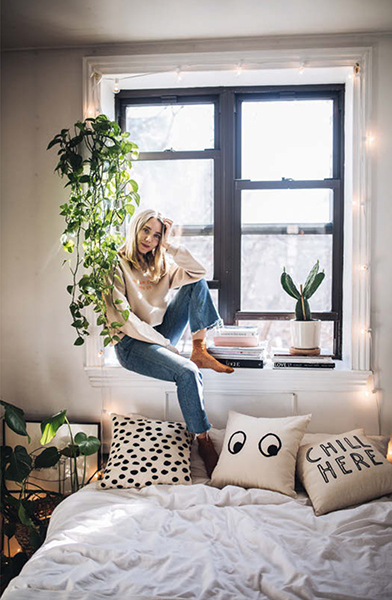
Life is buzzing in this bright and spacious two-bedroom condo in the heart of Brooklyn’s Williamsburg neighborhood. It’s home to Viktoria Dahlberg, a Swedish native who moved to the Big Apple five years ago. The delivery guy is a regular at her doorstep, and there are samples of new products patiently waiting to be reviewed and approved. This is where Viktoria works on her fresh home decor brand called N5 & SUNNY, which carries embroidered cushion covers, eco-friendly pillow inserts, and more.
“Plants help me calm down in these busy and stressful times,” says Viktoria. “My brand keeps me super busy with long days and that’s where plants come into play—they work magic, helping me find my balance when I return home to my Williamsburg apartment.” Taking care of her small gang of eleven plants—misting the Strelitzia nicolai, watering the golden pothos—encourages her to take it slow and stop thinking about emails, delivery guys, and phone calls.
But plants don’t only help Viktoria keep a healthy balance in her life; they also inspire her to create a stylish look for her own lifestyle brand and for clients. “Every photo looks better with some plants! But even if I didn’t have to create content for work, I would still live in a minimalist apartment with a lot of houseplants. I grew up in a forest in Sweden, and love for nature is part of my Swedish heritage. I feel best when surrounded by greenery.” This is evident throughout her home: a minimalistic white canvas with a dash of textures, playful textile designs, and plants.
Plants move around Viktoria’s apartment all the time, according to their needs as well as the needs of styling projects. Four months ago, she bought an oversize cactus (Cereus peruvianus) in the Flower District in Manhattan, which came with a shorter cactus in the same pot. One day it fell over and she realized it was not rooted at all. But it is doing fine now and may grow strong new roots when the days get longer and warmer.
